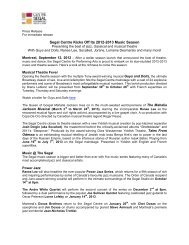STUDY
Check out our Study Guide! - Segal Centre
Check out our Study Guide! - Segal Centre
- No tags were found...
You also want an ePaper? Increase the reach of your titles
YUMPU automatically turns print PDFs into web optimized ePapers that Google loves.
Notes on Mahalia Jackson<br />
1911-1926: Early Life in New Orleans<br />
Born in 1911 in New Orleans, Mahalia Jackson grew up in a shotgun home shared by 13 people, in<br />
the care of her aunt following the death of her mother. Economic circumstances forced Jackson to quit<br />
school and go to work at a young age. Her earliest influences were in Uptown New Orleans: hot jazz<br />
bands, the beat-driven music of the Sanctified Church, and Bessie Smith’s bluesy voice. But Jackson’s<br />
greatest inspiration was at Mt. Moriah Baptist Church, where she sang six times a week.<br />
1927-1936: Life in Chicago<br />
Like many African Americans at that time, Jackson moved north to Chicago with her aunt at the age of<br />
16, hoping for better opportunities. She joined the Greater Salem Baptist Church once she arrived, and<br />
began touring with the Johnson Brothers, Chicago’s first professional gospel group. During this period,<br />
Jackson made a vow that she would live a pure life, free of secular entertainment. She promised to use<br />
her voice exclusively for spiritual music — a promise that she kept.<br />
1937-1946: Early Success<br />
By 1937, Jackson had made her first set of recordings with Decca Records, but refused to make a blues<br />
record, remembering her pledge to sing only gospel music. She lost her contract with Decca as a result.<br />
Gospel music was becoming popular in Chicago churches, and Jackson was building a community of<br />
gospel musicians. Among these was Thomas Dorsey, a talented Atlanta-born African American composer<br />
and pianist. He chose Jackson out of all the singers in Chicago to be his partner, and, as a traveling act,<br />
the two ushered in the Golden Age of Gospel.<br />
1947-1956: Radio, Television and Tours<br />
In 1948, Mahalia Jackson recorded “Move On Up a Little Higher” for Apollo Records, selling one<br />
million copies in the United States. With her riveting contralto, Jackson was as captivating as popular<br />
blues singers, and gospel’s bouncing beat proved just as danceable, even for audiences outside of<br />
church. Amidst a constant battle with racism and segregation, especially in the South, she still earned<br />
hundreds of dollars for a single concert. In 1950, she was invited to perform at Carnegie Hall at the<br />
First Negro Gospel Music Festival, a monumental event in the history of gospel music.<br />
1957-1960: The Queen of Gospel<br />
Jackson found mainstream success in the late ‘50s, touring the world and recording several successful<br />
albums for Columbia. Though television networks would not grant her a show of her own, Jackson did<br />
appear as a guest on many “white” variety shows including those hosted by Dinah Shore, Steve Allen,<br />
and Ed Sullivan. By 1960, Jackson was an international star. Her congregational call-and-response<br />
style, combined with her soulful, voluminous voice, made gospel music popular all over the world. But<br />
back home, Jackson’s financial success brought racist backlash, and her personal safety was often<br />
threatened.<br />
1961-1968: Fight for Civil Rights<br />
Mahalia Jackson’s struggle with racism had urged her to get involved in the Civil Rights movement at<br />
its onset. As early as 1956, Civil Rights leaders called on Jackson to lend both her powerful voice and<br />
financial support to the rallies, marches, and demonstrations. While lending her support to boycott<br />
leader Reverend Ralph Abernathy, she met a young preacher named Martin Luther King, Jr., whose<br />
speeches inspired Jackson, and they became friends.<br />
1969-1972: Final Years<br />
By 1969, with Kennedy, King, and many of her other contemporaries deceased, Jackson had retired<br />
from the political front. She had battled illness for years. Still touring almost to the end, she visited<br />
Africa, the Caribbean, Japan, and India, where she met Indira Ghandi, an instant fan. Jackson’s final<br />
performance was in Germany in 1971. Soon after an operation on her abdomen, she died of heart<br />
failure in January 1972, at the age of 60.<br />
Mahalia Jackson received a Grammy Lifetime Achievement Award in 1972 and was inducted into the<br />
Rock & Roll Hall of Fame in 1997.<br />
5



